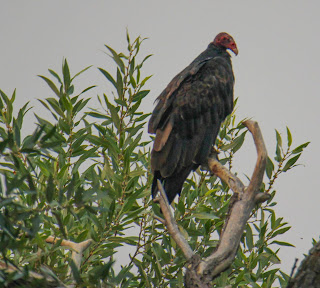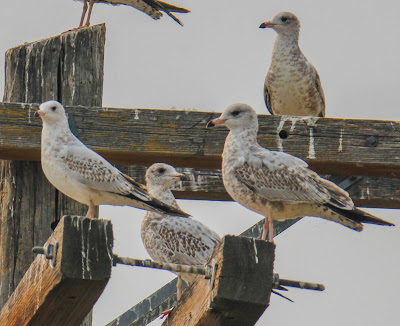Important Bird Areas (IBAs) are areas for which protection is sought for birds. BirdLife International partners with Audubon in the U.S. to identify, monitor and protect the IBAs in the U.S.
We recently visited the Klamath Basin - Clear Lake IBA which is on both sides of the California/Oregon border east of I-5 and includes Lower Klamath NWR and Tule Lake NWR, on the floor of the Klamath Basin, and Clear Lake NWR which is on the edge of the Modoc Plateau and drains into the Klamath Basin. In the summer when western refuges are losing water, the Klamath Basin can retain 23,000 acres of wetlands, probably the largest aggregation of any site in California. Nearly a million waterfowl, about 10% of the individual waterfowl on the Pacific Flyway, pass through this IBA each year. We were there at a slow time of the year, but we still saw enough wildlife to make it rewarding.
Clear Lake NWR is closed to public access except for some hunting, so we were not able to visit there (see map here - if you extend the linked map you will see that it is directly east of Tule Lake NWR). It has 20,000 acres of open water and is surrounded by 26,000 acres of upland bunchgrass, low sagebrush and juniper habitat. Clear Lake Reservoir is the primary water source for crops in the eastern Klamath Basin.
Lower Klamath NWR was established by President Theodore Roosevelt in 1908 as the first waterfowl refuge in the U.S. It is 50,913 acres, 6,618 acres in Oregon, below Klamath Falls, Oregon, and 44,295 acres in California (see this map). It includes shallow freshwater marshes, open water, grassy uplands and croplands that are managed to provide foraging and breeding habitat for waterfowl and other animals. We drove at least part of the 10.2 mile auto tour route (see map).
We saw a number of red-tailed hawks
and turkey vultures,
and some ducks and American coots.
 |
| Female cinnamon teal |
 |
| Female mallard |
 |
| An adult American coot with two juveniles. |
My most exciting find were two sandhill cranes which I didn't even notice until I got home and was looking at my photos. While I was photographing a flying red-tailed hawk the sandhill cranes were in the background.
Finally, we saw a great blue heron and some red-winged blackbirds.
Tule Lake NWR is 39,116 acres and is just east/southeast of Lower Klamath NWR (see map). It was established in 1928 by President Calvin Coolidge. It includes uplands vegetated with grasses and shrubs, such as sagebrush, and wetlands such as marshes. It includes about 19,000 acres of croplands leased to farmers which grow alfalfa, cereals, horseradish, potatoes and onions. We also drove part of the 12 mile auto tour route there (see map).
We saw more birds at Tule Lake. One of my favorite sightings was the American white pelican, which we saw individually and in pairs, floating on the water, and a huge flock congregated on the ground.
 |
| It was also fun to see some Caspian terns mingling among the white pelicans. |
I was also happy to see cackling geese, which look like small versions of the Canada goose, for the first time.
I also got my best view of a white-faced ibis, which I've seen once before near Alamosa, Colorado.
I saw my first black-necked stilt,
a bunch of snowy egrets,
a great egret (we saw more, but they were always on Judy's side of the car),
some juvenile ring-billed gulls,pied-billed grebes (but they were always far out on the water),
lots of American coots (usually too far out in the water for good photos) and some female mallards,

































It is encouraging to know that places like this still exist--natural habitats that are preserved for the purpose of preserving species. I feel like so many of these places are being gobbled up by development and misplaced legislation. I'm glad we had the opportunity to see these birds in more or less their natural habitat.
ReplyDelete